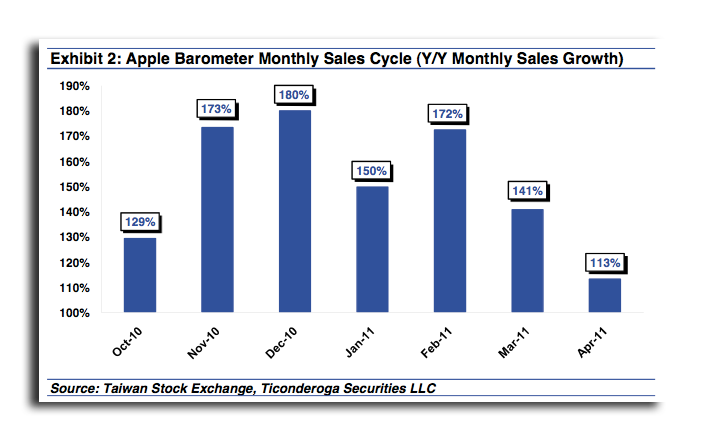Supply chain data shows Apple sales up 113% in April
Sales estimates are determined through the "Apple Barometer" tracked by Ticonderoga Securities, created earlier this year to track monthly sales trends in the Taiwan tech supply chain. Apple's presumed 113 percent year over year growth remains strong, though it is less than the 141 percent that analyst Brian White tracked in March.
The Apple Barometer shows that sales in April over the last six years have, on average, increased 0.4 percent month over month, and in 2010 they rose by 4.4 percent. However, in 2011, sales decreased by 7.5 percent month over month.
The larger-than-average decrease can be attributed to a huge March, where component supplier sales were said to be up 35 percent month over month. That was significantly better than the six-year historical increase of 24 percent month over month in March.
"Therefore, despite a weaker than normal April this year, the Apple Barometer can nearly deliver average sequential sales growth performance in (the second quarter of 2011) versus historical metrics," White wrote in a note to investors on Wednesday.
Apple's outlook for the June quarter, issued in its quarterly earnings report last month, called for a sequential sales decline of 7 percent. That would be much weaker than Apple's eight-year average, over which the company has seen a typical 5 percent sequential increase in the June quarter.
So far in 2011, the Apple Barometer has shown year over year sales increases of 150 percent in January, and 172 percent in February. It tracks sales trends in industries including LCD panel makers, touchscreen providers, and printed circuit board fabricators.
White and Ticonderoga Securities noted that the barometer indicates a trend in sales, but added that there is a "lag" between when suppliers recognize sales and Apple ships a product to its customers. The barometer is portrayed as a "reliable indicator of sales trends," a method more dependable than tracking a single company like Foxconn, which generates 75 percent of its sales from companies other than Apple.
Instead, the proprietary index consists of Taiwan-based suppliers who derive a significant portion of their revenues from Apple, which White estimates contributes between 50 percent and 60 percent of the total revenue generated in the barometer.
 Katie Marsal
Katie Marsal











 Andrew Orr
Andrew Orr
 Wesley Hilliard
Wesley Hilliard
 Amber Neely
Amber Neely

 William Gallagher
William Gallagher

 Malcolm Owen
Malcolm Owen








